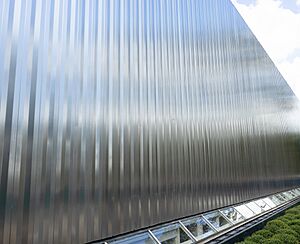Contemporary Arts Museum Houston facts for kids
 |
|
| Established | 1948 |
|---|---|
| Location | 5216 Montrose Boulevard, Houston, Texas 77006 |
The Contemporary Arts Museum Houston (CAMH) is a special place in Houston, Texas. It opened in 1948 and is all about showing contemporary art to everyone. Unlike some museums, CAMH doesn't collect art to keep forever. Instead, it focuses on displaying new and recent art. It helps people understand modern art through fun learning programs. The museum building you see today opened in 1972.
Contents
A Look Back at CAMH's History
How It All Started
In 1948, a group of seven people in Houston had a great idea. They wanted to create a museum to show new art and explain how art fits into modern life. They did this through art shows, talks, and other activities. At first, the museum didn't have its own building. It held shows in different places, sometimes even at The Museum of Fine Arts. Some of their first shows featured famous artists like László Moholy-Nagy.
By 1950, the museum was doing so well that it built a small, professional space. Here, they put on amazing shows with art by Vincent van Gogh, Joan Miró, and Alexander Calder. They also showed works by John T. Biggers and his students from what is now Texas Southern University. People in Houston were excited to see these new ideas!
Becoming More Professional
A big change happened in 1957. The museum, which had been run by volunteers, hired its first professional director, Jermayne MacAgy. She quickly organized many important shows. These included exhibitions about Piet Mondrian, Surrealism, and even Mark Rothko's second museum show ever.
During the 1960s, the museum kept focusing on different themes, architecture, and design. They also featured individual artists. Important shows included "The Emerging Figure" and works by Robert Rauschenberg.
By the end of the 1960s, the museum's first building was too small. So, the museum's leaders bought land and built a new home. This new building, designed by Gunnar Birkerts, opened in 1972. Its first show, called Ten, featured artists using new kinds of materials. Throughout the 1970s, the museum continued to show new art from across the country and Texas. This included shows for Hispanic artists and early works by Texas artists like James Surls and John Alexander.
Growing and Reaching Out
In the 1980s, the museum grew a lot. It showed art that included performance art and contemporary still-life paintings. There were also shows featuring groups of Texas artists. Many famous artists had solo shows, like Ida Applebroog, Robert Morris, and Frank Stella.
The museum also started a special series called Perspectives. These were quick, exciting shows in the lower gallery. They focused on new works by both rising and well-known artists who hadn't shown in Houston before. By 2011, over 175 Perspectives shows had taken place!
In the 1990s, the museum decided to focus only on art made in the last 40 years. It also worked to bring in art from all over the world. Big shows at this time included works by The Art Guys, Tony Cragg, Ann Hamilton, Richard Long, Tony Oursler, Lari Pittman, Robert Rauschenberg, James Turrell, and William Wegman.
The Museum Today
On January 1, 1997, the museum closed for its first big update in 25 years. It reopened on May 10, 1997, with a show called "Finders/Keepers." This exhibition showed how much the museum cared about its community. It borrowed important artworks back from private collectors who had bought them after they were first shown at CAMH. Other important shows since then have included "Elvis + Marilyn: Two Times Immortal" and "Abstract Painting Once Removed."
As the new millennium began, the museum looked back at some of its past shows with "Outbound: Passages from the Nineties." Other exhibitions in the 2000s included "Afterimage: Drawing Through Process" and "Subject Plural." Solo shows focused on different types of art, featuring artists like Alighiero e Boetti, William Kentridge, Uta Barth, and Juan Muñoz.
Museum Leaders
- 1979-1989: Linda L. Cathcart
- 2009–2018: Bill Arning
- 2020–present: Hesse McGraw
See also
 In Spanish: Contemporary Arts Museum Houston para niños
In Spanish: Contemporary Arts Museum Houston para niños

